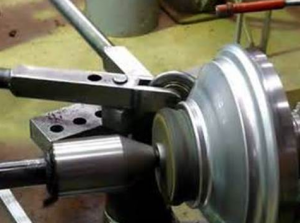 Metal spinning is the process of metalworking where a piece of metal is rotated at high speed to be cut and formed into a specific part. Vulcan GMS uses metal spinning to create customized asymmetrical machine parts.
Metal spinning is the process of metalworking where a piece of metal is rotated at high speed to be cut and formed into a specific part. Vulcan GMS uses metal spinning to create customized asymmetrical machine parts.
Metal spinning has been around for thousands of years. In fact, image evidence shows that ancient Egyptians used a form of metal spinning on the tomb of the pharaoh Petosiris. Read more about the history of metal spinning on the ThomasNet.com site.
The process begins with metal blanks or cylinders cut to a specific size and diameter based on the size of the finished part. A tool is made to generate the internal shape of the finished part. This tool is typically aluminum or hardened steel depending on the metal and quantities that will be made.
In this process, the tool spins and generates the internal shape of the product so that it can be spun into a cylinder, dish, tubular part, round shape, etc. Shapes that are not round in nature cannot be spun, but may lend themselves to press forming.
In the metal spinning process, the raw blank is placed against the inner mandrel and held there with pressure applied to the blank. The spinning machine is engaged and the tool and raw blank begin to spin.
Then a series of tools with roller wheels, which form edges and cutting edges, are used to move the metal to conform to the inner tool. The roller wheels move the spinning metal against the inner mandrel until it is tight to the core (tool). After the part is formed tight to the corner, tools can be used to create sharper radius corners. Also, knife cutters can be used to trim the ends of the spun part.
Once the part is finished, the machine is disengaged and the tool and part stop spinning. The part is pushed out of the core (tool) when it is complete. Secondary trimming or machining can be performed at that time.
If the part has tight wall thickness tolerances, sometimes thicker metal is used to provide the shape and then a secondary lathe operation will be used to trim away material for a more accurate tolerance on the wall thickness. In addition, any secondary processing can be performed at that time including general machining, trimming, brazing, assembly and more.
Metal spinning can be done with many metals including but not limited toL aluminum, mild steel, stainless steel, copper, brass, lead, tin and other metals and alloys. This process is a good way to produce any volume of parts needed. However please be aware that the process will require a unique tool for each part so there will be associated tooling costs.
For more information please contact us.
